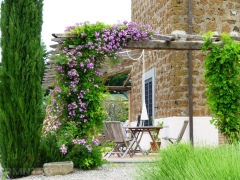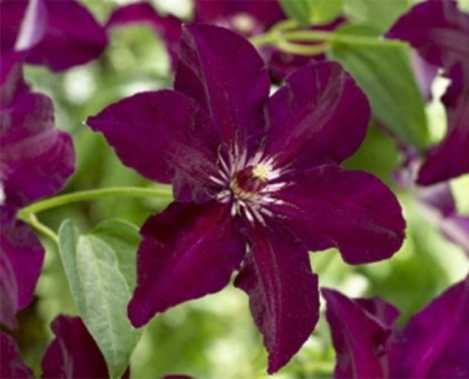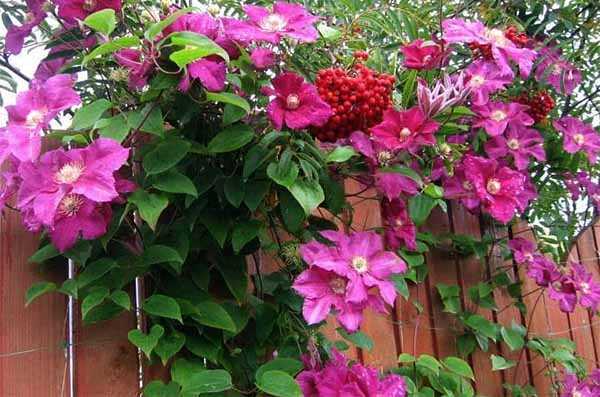Planting and caring for the princes
In nature, wild species of princes are found in almost all mountainous regions of Eurasia - from the Alps to the Caucasus and the Himalayas. It follows from this that the princes are mountain plants that thrive on dry rocky soils. Therefore, for planting these vines, it is recommended to choose a dry place without stagnant water. On heavy damp soils in the planting pit, it is better to arrange drainage.
Considering that princes grow in nature on poor soils, these plants are undemanding to the level of fertility and do not need additional fertilizers to be added to the planting hole when planting on moderately fertile garden soils. In terms of texture, the soil should be loose, light and permeable. In terms of soil reaction, liana prefers a slightly alkaline or neutral substrate.
Princes can grow and bloom in an open sunny place, but in this case, their leaves and flowers will become smaller, and their petals will burn out. In addition, the total flowering period is shorter in sunny places than in partial shade, although the vines bloom earlier. Therefore, for the princes, it is better to choose shady or semi-shady places.
It is also important that the plantings are located in places protected from strong winds, otherwise fragile stems and flowers may suffer from gusts of wind.
Most varieties and hybrids of princes are quite winter-hardy and belong to zone 3 (up to -40 ° C) or 4 (up to -34 ° C) and they do not need any shelter for the winter. It is also impossible to cut the stems in the fall, since in the spring flowering will begin on last year's stems. If necessary, sanitary or formative pruning is carried out after the completion of the first wave of flowering.
It is necessary to water the vines regularly only in the first year after planting, then their long deep roots will themselves be able to extract water from the deep layers of the soil. Adult princes water only during drought. These plants can do without additional feeding, however, to obtain larger flowers, they can be fertilized with complex fertilizer during the budding period.
 The princes will perfectly disguise any fence. Leszek cylupa
The princes will perfectly disguise any fence. Leszek cylupa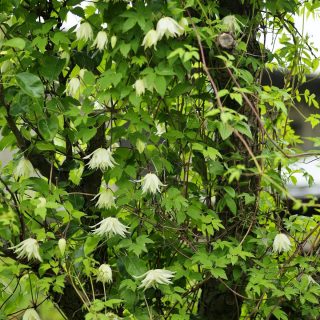 The princes are good for decorating the trunks of old trees and snags. Leszek cylupa
The princes are good for decorating the trunks of old trees and snags. Leszek cylupa
Watering and fertilizing clematis
Clematis should be watered abundantly, especially after planting, for several weeks until the roots take root in the new soil. Adapted plants need to be watered only during drought and hot weather, with intensive wetting of the root ball once a week.

Light watering can be done every two days. Mulching the soil around the plant stems with mature compost protects against moisture loss and also enriches the soil with nutrients.
Clematis is a rather gluttonous plant that requires a large dose of potassium. Having picked up the right fertilizer for him, it is worth applying it to the ground in late winter or early spring, in accordance with the manufacturer's instructions. This procedure must be repeated every year before the start of the growing season.
Description
If we consider this plant in more detail, then first of all it is worth saying that the princes are considered rather close relatives of such a plant as clematis. They are referred to the Atragene group. They differ from their relatives quite a bit. The first thing that catches your eye is the longer vines, the size of which reaches 4.5 meters.
The princes bloom very early, in early May. However, there are earlier varieties that bloom from April to May. They can be used to decorate areas located in cities with a warm climatic zone.

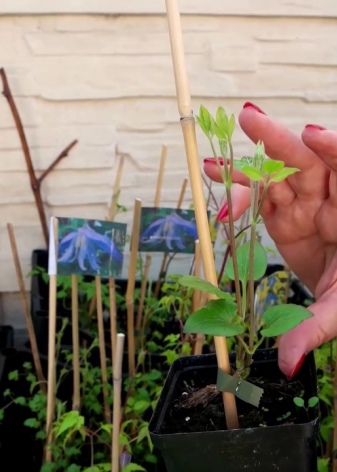
The vines of the plant are quite flexible and covered with carved leaves that stand out in a light green tint.They can be attached to any support with long petioles that twist in any direction.
The prince's flower is an elongated bud up to 9-12 centimeters in size. It looks a bit like a bell. They grow singly. The calyx itself consists of 5-7 sepals. The color can be very different and depends on the type of plant. They can be white, pink, or even blue. Flowering lasts quite a long time - from one to one and a half months. And at the end of August, fruits appear in place of flowers, that is, round boxes containing seeds.


Liana care
Watering. Watering Knyazhik is recommended once a week. The amount of water should be such that the soil is moistened about half a meter deep. 2 days after watering, the soil is loosened, weeds are removed. In the dry season, watering is carried out more often - 2-3 times a week. To retain moisture, the soil must be mulched.
Top dressing. They should be carried out at least 2 times a month. The first feeding should be carried out at the beginning of the growth of shoots and during the period of bud formation, further - after the completion of flowering and pruning.
Support. Like any liana-like plant, the Knyazhik needs a special support that will protect it from mechanical damage.
Preparing for winter. Most of the Knyazhik species are frost-resistant, well tolerant of frost. But if the winter is snowless, in order to avoid freezing of the shoots, it is advisable to remove the plant from the support, cover it with spruce branches.
Diseases. Under unfavorable conditions, Knyazhik can be affected by such diseases as powdery mildew, brown spot, rust, rootworm nematode. You can fight diseases by spraying vines with appropriate fungicide solutions or other plant protection products.
Pests. The prince is very fond of snails and slugs, a mealybug. They damage the leaves of the plant, its shoots. Rodents - mice, rats and even hares - can also harm the plant.
Planting clematis
If you decide to settle this blooming liana in the country, then before planting you need to think over the main points: choose the right place and seedling, decide when it is better to plant clematis, and not be mistaken with the pruning method.
Landing dates
There are two periods of optimal planting of clematis in the summer cottage. The first option is the beginning of spring, usually April, when the buds have not yet begun to bloom. The second - late August-early September, at this time it is still warm enough, and the seedlings have time to take root before the onset of frost.
When planting in spring, the plant is not allowed to bloom in the first year, breaking off the buds so that the bush does not weaken. And if the seedling has already developed a root system in the fall, then in the spring it begins to actively form shoots, and in the summer full flowering is possible.
Pick-up location
For the successful cultivation of clematis, several conditions must be met for choosing a planting site.
Abundant flowering is possible only in good lighting conditions. Therefore, it is better to plant clematis in an open, sunny area. Possibly light shading at noon
In the southern regions, where the sun's radiation is very intense, it is better to choose a light partial shade, otherwise the roots may overheat and the flowers may fade.
It is imperative to protect the vines from the wind. In the summer, it breaks young stems and flowers, and in the winter it blows away the snow, which leads to the freezing of the buds.
You can not plant clematis in the depressions of the relief
Cold air and water from melting snows and rains accumulate there. If there is no other option, then it is necessary to arrange grooves to drain water from the site.
Smooth areas are also not suitable if the water table is above 1.2 m.
The soil for growing clematis needs light, but fertile: loose sandy loam, loam, rich in humus. The reaction of the soil is from slightly acidic to slightly alkaline.
You need to retreat from the walls at least 50 cm.
Carefully! Do not place clematis close to a metal fence, this will lead to sunburn
Selection and preparation of a seedling for planting

Usually one- or two-year-old seedlings are on sale. Clematis suitable for planting should have a well-developed root system (at least 3 roots from 10 cm long), 1-2 powerful stems, at least 2 unblown buds in spring or 3 developed in autumn
It is important to know the name of the variety in order not to be mistaken with the choice of the pruning method.
If the seedling is bought too late in the fall, you need to dig it in until spring. Clematis with dried roots is placed in a bucket of cool water for 6-8 hours. It is advisable to add root or epin to the water. Before planting, the roots of the seedling are disinfected with a weak solution of potassium permanganate.
Landing technique

With the right choice of place and the proper arrangement of the planting pit, clematis can grow in one place for up to 25 years.
- With a single planting, a hole is dug 60x60 cm in size and 60 cm deep. If you plan to plant several plants in a row, then dig a trench 60 cm deep and 60 cm wide. Broken bricks, expanded clay, fragments of earthenware or broken twigs with a layer of 10–15 cm are placed on the bottom to ensure drainage.
- If the soil is represented by loam, then the pit is filled with a mixture from the top layer of the excavated earth with humus, sand and peat (1: 1: 1: 1). In the case of sandy loam, one part of black soil, humus and peat is added to one part of the native soil. In both cases, the mixture is fertilized with ash (1 l) and a mineral complex (100 g). If the soil is acidic, then it is necessary to mix all the components with 50-100 g of slaked lime.
- The hole is half covered with prepared soil mixture, leaving a mound in the center. A clematis seedling is placed on the top of the hill, spreading the roots along the slopes. They hold the plant with one hand, and the roots are carefully covered with soil with the other. Clematis are planted with significant depth to stimulate the development of shoots, as well as protect them from frost and overheating. The larger the bush, the more it is buried. Young seedlings (1-2 years old) are deepened by 5-10 cm, adults - by 10-15 cm.
- The distance between the bushes should be at least 1 m.
- When landing, a support is installed.
- Immediately after planting, clematis is well watered and shaded, the soil is mulched with peat or a layer of dry grass 10-15 cm thick.
- Often only one stem develops in the first year, so it is recommended to pinch the top when planting.
general characteristics
Often the plant is also called clematis, although these vines are only relatives. They differ mainly in the structure of the flower.
The prince (Atragene) is a subgenus of lianas - perennials, which are part of the Lomonos genus and the Buttercup family (this combines the prince and clematis). Liana also has other names: lozinka, loch, wild hop. Under natural conditions, they grow in a temperate climatic zone, often in the north.
The sepals of this plant are large and they are bordered by completely invisible thin petals. Clematis have no petals at all. And what we take for them are sepals.
The word prince comes from ancient Greek and is translated as a tendril (clema). But it is precisely the antennae that this vine does not have. It clings to a net or support with the help of twigs with leaves and petioles.
- This plant is referred to as shrub vines. The stems are ligneous.
- Leaves are twice or three times pinnate.
- The flowers are single and axillary, rather large - about 10 cm in diameter. They look much more aesthetically pleasing than clematis flowering. They are also similar in structure to bells, on the branches they have a drooping shape.
- The fruits are collected in a fluffy head, there are quite a few of them on one bush.

The princes grow very quickly. When clematis is just beginning to wake up after winter, the prince is already turning green with might and main. The princes of several varieties look very beautiful - together they make up a very stylish composition and are able to decorate any flower garden or garden plot.
Diseases and pests of clematis
Diseases of clematis
Clematis can be affected by fungal, viral and bacterial diseases. The most dangerous disease is wilt, or wilting, from which the shoots suddenly lose their turgor and dry out. If you do not pay attention to the signs that have appeared and allow the disease to take effect, you can lose the plant. In addition to wilt, clematis can suffer from gray rot, rust, ascochitis, alternaria, septoria and powdery mildew. Rust appears as powdery reddish-brown spots on the leaves and shoots of clematis, and powdery mildew - as a sloppy whitish bloom. From gray rot, brown spots and gray fluffy bloom appear on the tissues of the plant. Signs of Alternaria - dark gray necrotic spots with a velvety olive bloom on old leaves and shoots of clematis, with ascochitis and septoria, spots also appear on the leaves, which eventually increase, merge with each other, and then necrotic areas form on them, tissue from which , collapsing, spills out. All these diseases, if left untreated, can lead to the death of clematis.
To avoid the defeat of clematis by fungal diseases, for prevention purposes, it is necessary to treat the bushes with a solution of iron or copper sulfate in early spring and during the period of leaf fall, and in the summer with a solution of the Hom preparation. At the first signs of a fungal disease, clematis is sprayed with Fundazol, Topaz, Skor, a one percent solution of Bordeaux liquid or other copper-containing preparations. Do not forget to first remove the diseased shoots and leaves from the plant and burn them.
As for viral and bacterial diseases, they are, as a rule, incurable, therefore, they can only be resisted by adhering to agricultural technology, timely and conscientious care and the implementation of regular preventive measures.
Pests of clematis
Of the pests, clematis most often has trouble with gall nematodes, slugs, snails, spider mites, aphids and thrips.
The larvae of nematodes penetrate into the root of the plant and settle in it, causing strong growth and the formation of blisters on the roots - galls, which grow and turn the roots into a shapeless mass. At the initial stage, the occupation of clematis by nematodes is difficult to detect, and when the presence of the enemy becomes obvious, the plant, as a rule, cannot be saved. Therefore, it is possible to fight nematodes only with preventive measures: checking the planting material for the presence of galls, mulching the surface around the bush with chopped wormwood or mint, planting calendula, marigolds, parsley, dill, watercress - plants that repel nematodes next to clematis bushes. Clematis affected by the pest should be burned, and the soil in which they grew should be treated with Carbation or Nemagon preparations.
The fight against other pests is carried out with the help of an infusion of garlic, a solution of soap with tobacco dust, an infusion of onion husks, and Fitoverm or Kinmix are used from insecticidal preparations. Gastropods are lured onto cabbage leaves and destroyed.
Varieties of varieties
There are several of the most popular types of clematis Knyazhik:
| View | Description |
| Alpine | The natural habitat is the forests of Europe and the Baltic states. The flowers are in the form of large bells, on them there are 4 sepals, in which the petals are hidden. Among the shades that characterize this variety, stand out: pink, lilac, blue and purple. The rich green leaf plate has a triple shape and serrated edges. The flowering period begins at the end of May. Popular varieties of this type of Knyazhik:
|
| Large-lobed | The homeland of this species is the Far East, as well as Korea, China and Siberia. A feature of the large-petaled Knyazhik is the terry structure of the inflorescence, which gives it splendor and elegance.There are more small petals covered with upper sepals in this species than in others. It is also more demanding in the care and especially in the shelter of the bush in the winter.
The following varieties of this type are widespread:
|
| Siberian | Under natural conditions, it is found in the coniferous forests of Russia. The bush can grow up to 3 meters. The species is distinguished by abundant flowering. Flowers are white or yellowish in color, resemble bells in shape. The flowering period falls in the middle of the summer season. Often pleases gardeners with repeated flowering in early autumn. This Knyazhik is distinguished by frost resistance and a delicate, sweet aroma emanating from flowers. |
| Korean | The least popular species, rarely found in Russia. It features bright yellow, red or purple flowers. The height can be from 2 to 3 meters. |












